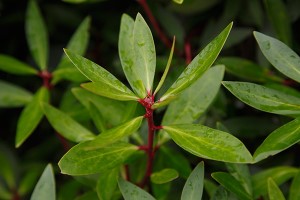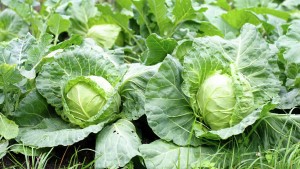- Houseplants
- 3,649
Wasabi is a popular Japanese condiment that has become popular all over the world. It is a spicy, horseradish-like flavor that is usually served with sushi and other Japanese dishes. Wasabi is often grown in home gardens and is surprisingly easy to care for.
While most wasabi sold commercially is actually a mix of horseradish, mustard, and green dye, the real thing is an attractive, slow-growing plant that is worth the effort of growing.
Here at Garden Pie, we shall look into a few tips to grow and care for wasabi.
Table of contents [Show]
What you need to know about wasabi
Wasabi, the Japanese condiment, is known for its intense and pungent taste, which can be quite overwhelming for some. But what exactly is wasabi and what does it do?
Wasabi is a plant whose root is ground into a paste and mixed with soy sauce for a spicy condiment. It is usually served as an accompaniment to sushi, but can also be used as a flavor enhancer in many other dishes. It is a member of the cruciferous family, which also includes broccoli, cabbage and horseradish. It has a strong, pungent flavor and aroma, and is usually bright green in color.
The taste of wasabi is complex and varies depending on the variety and preparation. Generally, it has a sharp and intense flavor that can sting the nose and eyes. It is also known to have a lingering aftertaste due to the presence of certain volatile compounds.
It is rich in several important vitamins and minerals, including vitamin C, potassium, magnesium and calcium. It also contains several plant compounds, including isothiocyanates, which have been linked to a number of health benefits, such as anti-inflammatory and antioxidant properties.
It also has long been used in traditional Japanese medicine. It is believed to have antibacterial, antifungal and antiviral properties that can help to protect against infection. It is also thought to help improve digestion, reduce inflammation and boost the immune system.
In addition to its health benefits, wasabi can be used to make a variety of dishes. It can be added to soups, sauces and dressings to give them a kick. It can also be used as a marinade for fish or as a topping for sushi.
When buying wasabi, make sure that it is fresh. Look for a bright green color, and avoid wasabi that looks yellowish or has an off-putting smell. If you can't find fresh wasabi, you can also purchase it in powder or paste form.
Facts about wasabi includes:
- Name: wasabi, Japanese horseradish, Wasabia japonica, Eutrema japonica.
- Height: 30–45cm.
- Foliage: evergreen rhizomatous perennial with large, heart-shaped leaves up to 30cm.
- Climate: prefers a humid environment in summer, with temperatures no lower than about 10°C and no higher than 20°C for much of the year. Best suited to the sub-tropics or tropics, although it can be grown in a sheltered microclimate or indoors in other areas.
- Soil: improve soil with organic matter such as well-aged manure or compost prior to planting. If growing in pots, choose a premium potting mix with excellent water storage capacity, as wasabi prefers a moist soil.
- Position: a shaded position with protection from wind, cold, sun and extremes of temperature. Self-watering pots are a good idea if growing indoors.
- Flowering: small white flowers appear in spring. These are also edible, although they will only appear under ideal growing conditions.
- Feeding: annual applications of well-aged manure are ideal.
- Watering: water daily in warm dry weather. Wasabi is a water plant in its natural habitat, so needs to be watered regularly.
Appearance and characteristics of wasabi
Appearance
Wasabi is a type of Japanese horseradish and is recognizable for its bright green color and spicy taste. It is a root vegetable that is harvested from the Wasabia japonica plant and is a member of the Brassicaceae family, which also includes other common vegetables such as broccoli and kale. Wasabi is usually sold in paste form, but can also be found in powder and grated form.
Characteristics
Wasabi is known for its pungent and spicy flavor, which is a result of the natural chemical compounds that it contains. These compounds, known as isothiocyanates, also give wasabi its distinct and recognizable odor. Wasabi is also rich in vitamins C and E, which are both important for maintaining a healthy immune system. Wasabi has antioxidant properties and has been shown to have anti-inflammatory effects as well.
Wasabi also has antibacterial properties and has been used for centuries in traditional Japanese cuisine as a natural preservative for fish and sushi. Wasabi has also been used medicinally by the Japanese for its ability to help stimulate digestion, reduce nausea and reduce the risk of foodborne illnesses.
Uses for wasabi
Wasabi is a unique and flavorful Japanese condiment that adds a unique, spicy kick to a variety of dishes. It is most commonly found in sushi restaurants, but its uses go far beyond sushi. Wasabi is also popularly used as a dip for crackers and chips and can be added to sauces, dressings and marinades for an extra kick of flavor.
Here are some of the most popular and interesting ways to use wasabi in your cooking:
- Sushi: Wasabi is a traditional accompaniment to sushi, used to give the fish and rice rolls a spicy kick. Most sushi chefs will use wasabi to season sushi rolls, and many people enjoy adding extra wasabi to their sushi for an extra punch of flavor.
- Sauces: Wasabi can be used to make a variety of sauces, from wasabi-soy to wasabi-mayonnaise. Wasabi-soy is particularly popular, and is a great dipping sauce for sushi. Wasabi-mayonnaise is also delicious, and can be used as a spread on sandwiches or as a dip for vegetables.
- Salads: Wasabi can be used to give salads an extra kick of flavor. It can be used as a dressing, or added to the salad itself. Wasabi can also be used to top a variety of salads, such as tuna, potato, or coleslaw.
- Marinades: Wasabi can be used as a marinade for fish, poultry, and beef. The flavor of wasabi can help to tenderize the meat, while also adding a unique flavor.
- Soups: Wasabi can be used to give soups a unique flavor. It can be used to season miso or other types of soup, or used as a garnish for ramen.
- Snacks: Wasabi can be used to season a variety of snacks, such as popcorn, chips, and crackers. It can also be added to dips, such as guacamole or hummus, for an extra kick of flavor.
How to plant and grow wasabi ?
For those looking to add a spicy kick to their dishes, planting and growing wasabi is a fun and rewarding experience.
Here's how to get started.
- Choose the right site. Wasabi thrives in moist, shady environments, so find a spot that gets partial sun and has good drainage.
- Prepare the soil. Wasabi grows best in acidic soil, so test your soil and add sulfur if necessary to bring the pH down.
- Plant the wasabi. Plant the wasabi rhizomes (the root-like stems) about 1-2 inches deep and 4-6 inches apart. Water thoroughly.
- Help it grow. Keep the soil moist but not waterlogged, and fertilize the wasabi with organic fertilizer every couple of months.
- Harvest. The wasabi is ready for harvest after about 12-18 months. Carefully dig up the wasabi rhizomes and rinse off any soil.
Enjoy! Grate the wasabi rhizomes and use it as a condiment to add a kick to your dishes.
Wasabi propagation
Wasabi plant is native to Japan, but can now be found in many parts of the world, due to its popularity and ease of propagation.
It is a perennial plant that grows in watery conditions, and can be propagated either through seed or rhizomes. The seed method requires a bit more time and patience, as the seeds take a while to germinate, but the rhizomes are much easier and quicker to propagate.
For the seed method, you'll need fresh wasabi seeds, which can be bought from a specialty store, or online. The seeds need to be sown in a shallow tray filled with a well-draining soil, and kept moist but not soggy. They should be kept in a warm and bright location, and should germinate within a few weeks. Once the seedlings emerge, they need to be thinned out and transplanted into individual pots.
For the rhizomes method, you'll need to buy a wasabi rhizome from a specialty store, or online. The rhizome should be planted in a shallow tray filled with moist soil, and the tray should be kept in a warm, bright location. The rhizome should sprout within a few weeks, and the sprouts should be transplanted into individual pots.
To ensure that the wasabi plants grow properly, they need to be kept in moist and acidic soil, and need to be watered regularly. They should also be protected from direct sunlight, as too much heat can cause them to wilt and die.
Caring for wasabi
If you are interested in growing and caring for your own wasabi, there are a few key things to keep in mind:
1. Wasabi is a slow-growing plant and does best in cool temperatures. It should be grown in a moist and shady environment, such as in a greenhouse or shaded area in your garden. The soil should be rich in organic matter and well-draining. If you don’t have access to a shaded area, you can also grow wasabi in containers or pots.
2. When planting wasabi, it is important to keep the roots consistently moist. Water the plants regularly and deeply, but avoid overwatering to prevent root rot. Mulching around the plants will help keep moisture in and prevent the soil from drying out.
3. It also has specific nutritional needs. It requires nitrogen and potassium to grow, so you may need to supplement the soil with fertilizer. You can also feed wasabi with compost tea or fish emulsion once a month during the growing season.
4. It is susceptible to pests and diseases, so it is important to inspect the plants regularly and take action if needed. Common pests include slugs, snails, and aphids. Organic insecticides can be used to safely combat these pests.
5. Finally, it is important to harvest the wasabi at the right time. The leaves should be harvested when they are still green, and the stems and roots should be harvested when the plant is about a foot tall. To ensure the best flavor and quality, you should use the wasabi immediately after harvesting.
Diseases and pests affecting wasabi
While wasabi is a hardy plant, it can be affected by diseases and pests. Knowing how to identify and manage these problems can help keep wasabi farmers and home gardeners successful in growing this unique and flavorful plant.
Diseases
Wasabi is susceptible to a variety of diseases, including viruses, bacterial infections, and fungal infections. One of the most common wasabi diseases is root rot, which is caused by a soilborne fungus. This disease causes the wasabi roots to become soft and discolored, eventually leading to plant death. Other diseases that can affect wasabi include powdery mildew, bacterial leaf spot, and potato virus Y.
Pests
Wasabi can also be affected by a variety of pests, including caterpillars, aphids, slugs, and snails. These pests can feed on the leaves, stems, and roots of the wasabi plant, leading to stunted growth and reduced plant vigor. Thrips are also a common pest of wasabi, and can cause leaf distortion, yellowing, and even plant death.
Management
The best way to manage diseases and pests affecting wasabi is to practice good cultural management techniques. This includes proper fertilization, proper irrigation, and avoiding overcrowding. Additionally, wasabi plants should be monitored regularly for signs of diseases and pests, and any problems should be addressed immediately.
In addition to cultural management, pests can be managed with insecticides, while diseases can be managed with fungicides. It is important to read and follow all directions on the label when applying these products. Additionally, it is important to rotate between different types of insecticides and fungicides to avoid the development of resistance in pests and diseases.
Conclusion
Growing and caring for wasabi is a great way to enjoy this flavorful ingredient in your home-cooked meals. Wasabi is native to Japan and is traditionally used to flavor sushi and other dishes. It is an attractive plant with serrated leaves and delicate white flowers, and with a little care and attention, it can be grown in most temperate climates.
With a little patience and some tender loving care, you can soon be harvesting your own wasabi and adding some zest to your favorite dishes.
Here are 21 tips to help you keep your wasabi plants healthy and thriving:
1. Plant wasabi in a well-draining soil that’s rich in organic matter. This will ensure that the wasabi gets enough nutrients and water to stay healthy.
2. Make sure your wasabi is planted in an area that receives partial to full shade. Too much direct sunlight can damage the delicate leaves.
3. Water your wasabi plants regularly, but make sure not to overwater them. Allow the top few inches of soil to dry out before watering again.
4. Fertilize your wasabi every two to three months using a balanced fertilizer.
5. To prevent disease, make sure to keep your wasabi plants free of weeds and other debris.
6. Prune your wasabi plants regularly to keep them from getting too large and unruly.
7. If you live in a cooler climate, you may need to provide some protection for your wasabi plants. Cover the plants with a tarp or other protective material during cold periods.
8. Wasabi can be sensitive to pesticides, so it’s best to avoid using them if possible.
9. If you need to use pesticides, make sure to choose ones that are specifically designed for wasabi plants.
10. Make sure to harvest your wasabi root when it’s mature. The root should be crisp and have a strong wasabi flavor.
11. If you’re harvesting wasabi for seed, make sure to allow the plant to set seed before harvesting.
12. When storing wasabi, keep it in a cool, dark place.
13. Wasabi can also be stored in the refrigerator or freezer.
14. When preparing wasabi, make sure to grate it with a fine grater. This will help to preserve the flavor and texture of the wasabi.
15. Wasabi should never be cooked or boiled, as this will destroy the flavor.
16. Wasabi pairs well with a variety of foods, such as sushi, sashimi, and tempura.
17. Make sure to use wasabi in moderation, as too much can be overpowering.
18. If you’re using wasabi for a sauce or dip, make sure to mix it with other ingredients to balance out the flavor.
19. If you’re growing wasabi indoors, make sure to provide plenty of air circulation.
20. If you’re growing wasabi in a container, make sure to use a pot that’s at least 8 inches deep.
21. Finally, make sure to enjoy wasabi for its unique flavor and health benefits.





